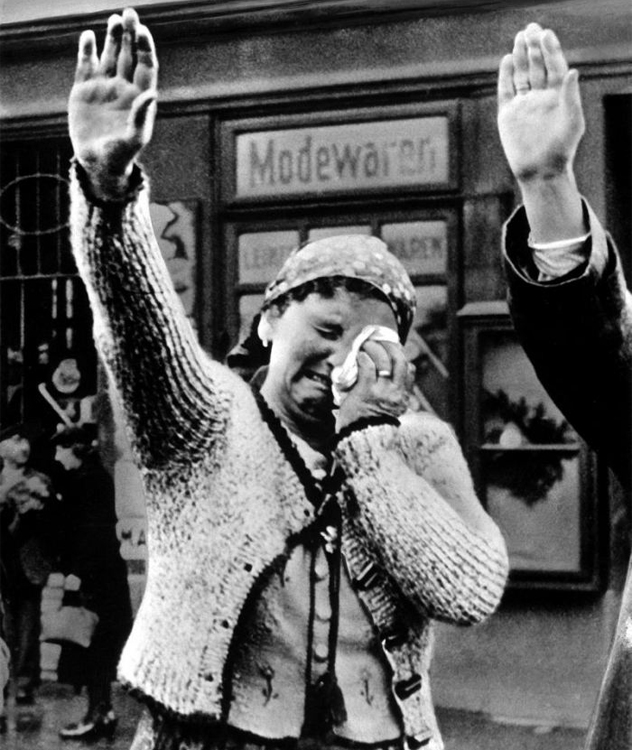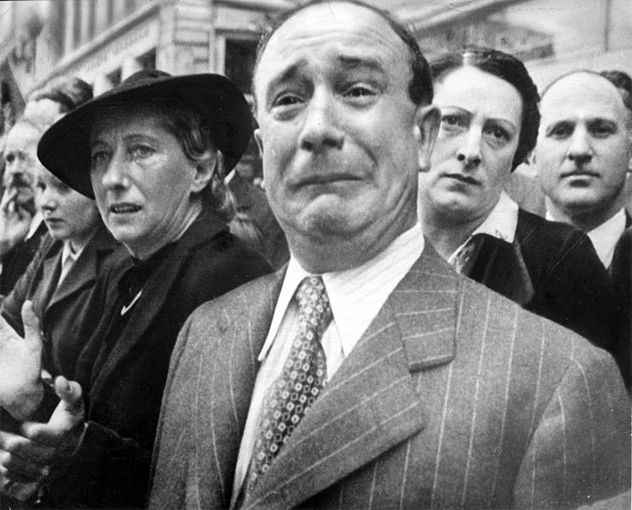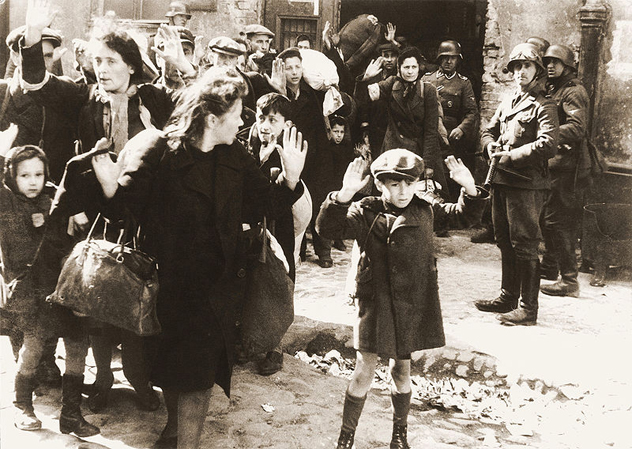7.The Weeping Woman Of Sudetenland
7.苏台德哭泣的妇女
This photo of a weeping Sudeten woman is one of the most controversial photographs of World War II. It was also a propaganda tool used by both the Allies and the Nazis. The photograph was taken in Sudetenland, Czechoslovakia, in October 1938 after the city was captured and annexed by Germany just before World War II officially began. The photograph shows a weeping Sudeten woman raising one of her arms to salute the invading German troops while the other hand holds a handkerchief over one of her tear-filled eyes.
这张记录苏台德哭泣妇女的照片是二战期间最受争议的照片之一。同盟国和纳粹都将其作为宣传之用。该照片摄于1938年10月,地点是(前)捷克斯洛伐克(Czechoslovakia)的苏台德,彼时正值二战爆发前夕,德国刚刚攻破并殖民这座城市。照片里这个哭泣的苏台德妇女抬起一只手向德国侵略军致敬,另一只手拿着手帕擦拭热泪盈眶的眼睛。

The photograph appeared in different newspapers in different countries with different captions. It was first published by a German newspaper, Volkischer Beobachter, which said that the Sudeten woman was so overjoyed by the advancing German soldiers that she could not hide her feelings. In the United States, one newspaper said that the women could not hide her misery as she "dutifully" saluted Hitler.
这张照片出现在不同国家的不同报刊上,并被附上了不同的解读。第一个发表该照片的是德国一家报社《人民观察报》(Volkischer Beobachter,纳粹党报),报道称这个苏台德妇女看到列队前行的德国战士无法掩饰自己激动不已的心情,喜极而泣;而美国一家报社则称该妇女难掩内心苦楚,却又不得不"忠诚地"向希特勒挥手致敬。
6.垂泪的法国人

In the summer of 1940, German soldiers rolled into Paris, marking the defeat of France and the beginning of "Les Annee Noires" also known as "The Dark Years." By the time the German soldiers began moving in, the French government had already abandoned the city and fled to Bordeaux in southern France, which was their last stronghold. The exact date the picture was taken is disputed. While it originally appeared in 1941, it is believed to have been taken in 1940. The man in the picture is believed to be Monsieur Jerome Barrett, who was crying as the flags of France made their way through Marseilles on their way to Africa.
1940年仲夏,德军攻入巴黎,标志着法国战败,也象征着"黑暗时代"(译注:"Les Annee Noires" 也被称为"The Dark Years")的到来。德军开始进攻之前,当局政府早就已弃城逃亡,撤退到法国南部的波尔多市(Bordeaux),那是他们最后的据点。该照片的拍摄日期尚未明确。它于1941年初次亮相,但人们却认为这张照片应是摄于1940年。法国沦陷之后,国旗经过马赛被运送至非洲的法属殖民地,照片中正为此事悲泣的男人应该是杰罗姆·巴雷特先生(Monsieur Jerome Barrett)。
The defeat of France during World War II was shocking as well as disappointing. Prior to the war, it was believed that France had the best army in the whole of Europe. After France fell to Germany, Adolf Hitler insisted that the documents to acknowledge the surrender of France must be signed in the Compiegne Forest, inside the same railroad car Germany had signed the documents of its own surrender in at the end of World War I. The railroad car was already in a museum, but it was removed and taken to the forest so the documents could be signed.
二战中,法国的战败令人胆战心惊而又失望至极。战前的法军曾是欧洲公认的最骁勇善战的一支军队。法国战败后,阿道夫·希特勒坚持要把签订法国投降书的地点安排在贡比涅森林(Compiegne Forest)中的一节列车车厢内。因为一战结束时,德国曾作为战败方在这节车厢里签订了投降书。当时这节车厢已然为博物馆所收藏,但还是被搬回森林以举行投降仪式。
5."小玩意"号原子弹

The atomic bombs that went off over Hiroshima and Nagasaki are sometimes said to be the first nuclear weapons. Actually, the two bombs weren't the first—they were just the first nuclear weapons deployed to kill and destroy. The first atomic bomb ever made was the Gadget (photograph above). It was completed and tested weeks before two other atomic bombs went off over Hiroshima and Nagasaki. The test, called Trinity, was carried out at the Alamogordo Bombing and Gunnery Range, known today as White Sands Missile Range, in New Mexico.
人们往往将两颗投放于广岛、长崎两市的原子弹视为第一代核武器。事实上,它们仅仅是"第一代"用于战争的核武器。"小玩意"(the Gadget, 见上图)才是原子弹的鼻祖。早在这两颗原子弹投放之前,"小玩意"(the Gadget)已经成功研制并顺利通过测试。该测试名为"三位一体核试"(Trinity),于新墨西哥州(New Mexico)的阿拉莫戈多导弹靶场(Alamogordo Bombing and Gunnery Range)进行。该靶场即如今的白沙导弹靶场(White Sands Missile Range)。
The bomb was placed on a forest service watchtower 30 meters (100 ft) tall. Three bunkers were constructed 9,000 meters (29,000 ft) away from the tower so that the impending explosion could be observed. In the early hours of July 16, 1945, the Gadget went off. The resulting explosion sent shock waves through the desert, vaporizing the tower and producing a gigantic mushroom cloud 12,000 meters (40,000 ft) high. It produced a flash brighter than 10 Suns. The flash was so bright that it was seen in all of New Mexico and parts of Arizona, Texas, and Mexico. The heat produced was so severe that observers 16 kilometers (10 mi) away compared it to standing in front of a "roaring" fireplace.
该枚原子弹放置于一座高30米(100英尺)的林务局瞭望塔内。距离塔身9000米(29000英尺)处建有三个掩体,旨在观测将要发生的核爆炸。1945年7月16日凌晨,"小玩意"(the Gadget)爆炸了。爆炸产生的冲击波穿越了整片沙漠,整座瞭望塔瞬间化为虚无,一朵高为12000米(40000英尺)的巨型蘑菇云直冲天际。爆炸瞬间产生的亮光远超10个太阳散发的光亮。整个新墨西哥州(New Mexico)连同亚利桑那州(Arizona)、德克萨斯州(Texas)及墨西哥州(Mexico)部分地区都能看到亮如白昼的光芒。爆炸同时释放出极高的热能,根据离爆炸点16千米(10英里)远的观察员描述,他们当时仿佛置身于一个"熊熊燃烧"的壁炉前。
4.华沙的犹太小男孩

We've already talked about the Warsaw Ghetto Uprising, when Jews in Warsaw, Poland, launched a 10-day revolt against German soldiers. The Jews knew quite well that they would be defeated, but they didn't want to give up without a fight. "The Warsaw ghetto boy" is the name given to a young Jewish boy, not more than 10 years old, who was arrested by German soldiers in the ghetto after the uprising had been crushed. The unidentified boy's hands were raised in the air while a German soldier pointed a machine gun at him. Although the photograph is one of the most circulated images of the Holocaust, no one knows who the boy is or what happened to him.
我们都知道华沙犹太人起义(Warsaw Ghetto Uprising),当时波兰华沙的犹太人发动起义,与德军对抗十天之久。犹太人知道起义肯定会失败,但是他们不想连一次反抗都没有就这样坐以待毙。"华沙犹太小男孩"指的是一个不满十岁的犹太小男孩,他在那次起义失败后被德国士兵抓进了"犹太区"。照片中,这个身份不明的小男孩双手举起,一名德国士兵拿枪瞄准了他。尽管这张照片是大屠杀时期流传得最广的照片,但是依然没有人知道他是谁,也没人知道他发生了什么。
Some sources say he was gassed to death at Treblinka camp, while others say he survived. In 1999, a man named Avrahim Zeilinwarger contacted an Israeli museum saying that the boy was his son, Levi Zeilinwarger, who was gassed to death in a concentration camp in 1943. In 1978, an unnamed man contacted the Jewish Chronicle saying that the boy was his son. In 1977, a woman named Jadwiga Piesecka claimed that the boy was Artur Dab Siemiatek, who was born in 1935. In 1982, a New York ear, nose, and throat specialist claimed that he could be the boy, although he himself doubted it. While he was arrested in Warsaw, he had never been to the ghetto. Besides, he was arrested on July 13, 1943, months after the picture is said to have been taken.
一些消息说他在特雷布林卡集中营(Treblinka camp)被毒气杀死,也有人说他活了下来。1999年,一个叫亚伯拉罕(Avrahim Zeilinwarger)的男士联系了以色列博物馆,说这个小男孩是他的儿子利瓦伊(Levi Zeilinwarger)已于1943年死于集中营的毒气室。1978年,一位不知名的男士联系犹太纪事报(Jewish Chronicle)也说小男孩是他的孩子。1977年,一位叫雅德维加(Jadwiga Piesecka)的女士声称这个小男孩叫阿特(Artur Dab Siemiatek),出生于1935年。1982年,一位纽约耳鼻喉专科医生说自己很可能就是照片中的小男孩,不过他也不是很确定。虽然他也曾在华沙被捕,但从来没有在犹太区待过。此外,他是在1943年7月13号被捕的,比这张照片拍摄的时间晚了几个月。
















